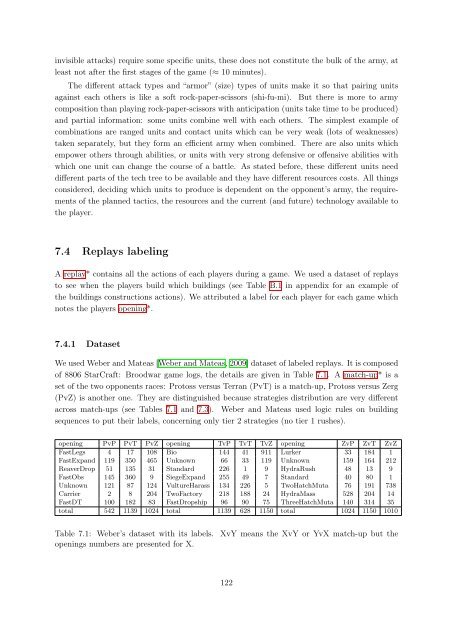Bayesian Programming and Learning for Multi-Player Video Games ...
Bayesian Programming and Learning for Multi-Player Video Games ...
Bayesian Programming and Learning for Multi-Player Video Games ...
You also want an ePaper? Increase the reach of your titles
YUMPU automatically turns print PDFs into web optimized ePapers that Google loves.
invisible attacks) require some specific units, these does not constitute the bulk of the army, at<br />
least not after the first stages of the game (≈ 10 minutes).<br />
The different attack types <strong>and</strong> “armor” (size) types of units make it so that pairing units<br />
against each others is like a soft rock-paper-scissors (shi-fu-mi). But there is more to army<br />
composition than playing rock-paper-scissors with anticipation (units take time to be produced)<br />
<strong>and</strong> partial in<strong>for</strong>mation: some units combine well with each others. The simplest example of<br />
combinations are ranged units <strong>and</strong> contact units which can be very weak (lots of weaknesses)<br />
taken separately, but they <strong>for</strong>m an efficient army when combined. There are also units which<br />
empower others through abilities, or units with very strong defensive or offensive abilities with<br />
which one unit can change the course of a battle. As stated be<strong>for</strong>e, these different units need<br />
different parts of the tech tree to be available <strong>and</strong> they have different resources costs. All things<br />
considered, deciding which units to produce is dependent on the opponent’s army, the requirements<br />
of the planned tactics, the resources <strong>and</strong> the current (<strong>and</strong> future) technology available to<br />
the player.<br />
7.4 Replays labeling<br />
A replay* contains all the actions of each players during a game. We used a dataset of replays<br />
to see when the players build which buildings (see Table B.1 in appendix <strong>for</strong> an example of<br />
the buildings constructions actions). We attributed a label <strong>for</strong> each player <strong>for</strong> each game which<br />
notes the players opening*.<br />
7.4.1 Dataset<br />
We used Weber <strong>and</strong> Mateas [Weber <strong>and</strong> Mateas, 2009] dataset of labeled replays. It is composed<br />
of 8806 StarCraft: Broodwar game logs, the details are given in Table 7.1. A match-up* is a<br />
set of the two opponents races: Protoss versus Terran (PvT) is a match-up, Protoss versus Zerg<br />
(PvZ) is another one. They are distinguished because strategies distribution are very different<br />
across match-ups (see Tables 7.1 <strong>and</strong> 7.3). Weber <strong>and</strong> Mateas used logic rules on building<br />
sequences to put their labels, concerning only tier 2 strategies (no tier 1 rushes).<br />
opening PvP PvT PvZ opening TvP TvT TvZ opening ZvP ZvT ZvZ<br />
FastLegs 4 17 108 Bio 144 41 911 Lurker 33 184 1<br />
FastExp<strong>and</strong> 119 350 465 Unknown 66 33 119 Unknown 159 164 212<br />
ReaverDrop 51 135 31 St<strong>and</strong>ard 226 1 9 HydraRush 48 13 9<br />
FastObs 145 360 9 SiegeExp<strong>and</strong> 255 49 7 St<strong>and</strong>ard 40 80 1<br />
Unknown 121 87 124 VultureHarass 134 226 5 TwoHatchMuta 76 191 738<br />
Carrier 2 8 204 TwoFactory 218 188 24 HydraMass 528 204 14<br />
FastDT 100 182 83 FastDropship 96 90 75 ThreeHatchMuta 140 314 35<br />
total 542 1139 1024 total 1139 628 1150 total 1024 1150 1010<br />
Table 7.1: Weber’s dataset with its labels. XvY means the XvY or YvX match-up but the<br />
openings numbers are presented <strong>for</strong> X.<br />
122


